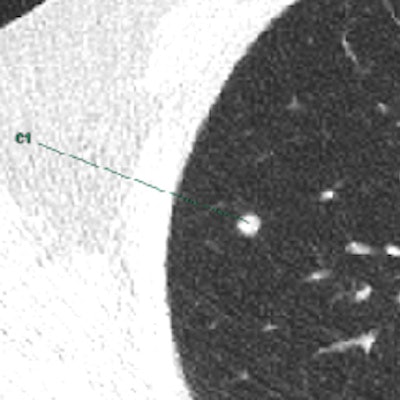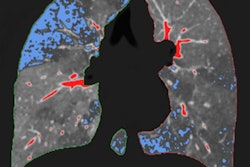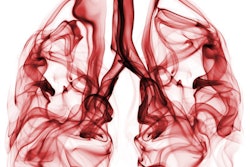
Iterative reconstruction (IR) can improve lung nodule detection with 3D computer-aided detection (CAD) to the point where nodule detection using ultralow-dose CT is comparable with standard and low-dose exposures, according to researchers from Japan presenting at ECR 2017 in Vienna.
In a study that examined the utility of advanced IR in a 3D CAD system for lung nodules, investigators from Kobe University and two other institutions in Japan scanned 40 patients to measure 3D CAD's ability to improve detection performance in the setting of standard dose, low-dose and ultralow-dose CT. They found that performance at standard-dose was not significantly better than low- or ultralow-dose CT when IR was used.
 Dr. Yoshiharu Ohno, PhD, from Kobe University.
Dr. Yoshiharu Ohno, PhD, from Kobe University."Iterative reconstruction ... is useful for improving nodule detection performance on a 3D CAD system on reduced dose and ultralow-dose CT as compared with filtered back-projection," said Dr. Yoshiharu Ohno, PhD, during his talk.
With the expanding use of multidetector-row CT for detecting lung cancer in heavy smokers, radiologists find themselves interpreting ever-larger numbers of thoracic CT images in a short time. Even so, interpretation efficiency and the consistency of results are crucial for maximizing the clinical benefits of low-dose CT lung cancer screening.
Several computer-aided lung nodule schemes have been developed to improve on the detection of lung cancers in screening in the face of large volumes of data -- and many studies support the idea that CAD is a successful tool to identify small pulmonary nodules on CT.
"Since 2004, we have been developing lung CAD systems while continually improving the detection sensitivity of lung-nodule detection at standard, low-dose, and ultralow-dose scans," Ohno said. To date, however, no one has evaluated CAD software at different dose levels including ultralow-dose CT, and the utility of reconstruction methods.
The study looked at nodule detection capabilities on 3D CAD using filtered-back projection (FBP) and IR methods at standard-, reduced-, and ultra-low-dose CT to determine the detection sensitivity improvement using advanced iterative reconstruction and the effect on the false-positive rate. Detection, sensitivity, and false-positives were analyzed among all protocols using McNemar's test or a signed rank test.
The cohort included 40 patients (21 men and 19 women) with suspected pulmonary nodules imaged at thin-section CT, which detected 48 solid and 53 subsolid nodules between 4 mm and 30 mm.
Images were acquired on either 64 detector-CT or 320-detector-row (Toshiba Medical Systems) CT scanners using 250 mA (standard dose CT, SDCT), 50 mA (reduced dose CT, RDCT), and 10 mA (ultralow-dose CT, ULDCT) protocols. The data were reconstructed into protocols with and without adaptive iterative dose reconstruction (AIDR3D, Toshiba Medical Systems, or filtered back projection, FBP). A 3D FC51 filter was applied as a lung kernel.
Two board-certified chest radiologists with more than 23 years of experience determined ground truth in consensus.
The investigators found no significant difference in the false-positive rate among all protocols, but there were wide variations in the sensitivities of RDCT and ULDCT when AIDR 3D was applied. Sensitivities of SDCT with and without AIDR 3D were significantly higher than that of RDCT without AIDR 3D (p < 0.0001) and ULDCT with and without AIDR 3D (p < 0.0001).
| Lung nodule detection sensitivity results at standard, reduced, and ultralow-doses, with and without iterative reconstruction | ||
| Method | Sensitivity | False-positive rate per case |
| SDCT with AIDR3D | 78% | 3.05 |
| SDCT with FBP | 80% | 2.63 |
| RDCT with AIDR3D | 81% | 3.05 |
| RDCT with FBP | 62% | 2.95 |
| ULDCT with AIDR 3D | 79% | 4.88 |
| ULDCT with FBP | 43% | 7.88 |
"In a comparison of sensitivities and false-positive cases among all dose protocols, reduced-dose CT with FBP showed significantly lower sensitivity than that of SDCT with AIDR3D," Ohno said. Reduced and ultralow-dose CT were also significantly more sensitive with AIDR3D.
"On the other hand, when comparing ULDCT with FBP, the sensitivity was significantly lower than the others, and in addition, the false-positive rate of ULDCT with FBP was significantly higher than that of the others," he said. When AIDR3D is applied, sensitivity and false-positives are not significantly different from standard dose CT levels.
IR is useful for improving nodule detection on 3D CAD systems at reduced doses as compared with filtered back projection reconstruction, so the dose can be decreased without affecting detection performance, he said.
"Iterative reconstruction is considered one of the most important factors for 3D CAD systems" for maintaining high CAD detection performance at very low doses, he said.



















